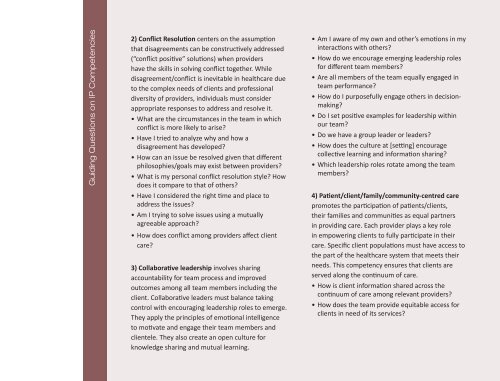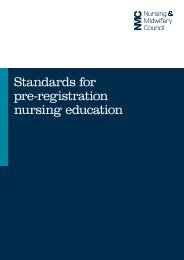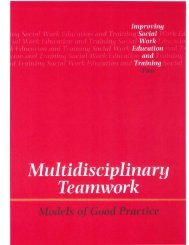Interprofessional Mentoring Guide - Alberta Health Services
Interprofessional Mentoring Guide - Alberta Health Services
Interprofessional Mentoring Guide - Alberta Health Services
Create successful ePaper yourself
Turn your PDF publications into a flip-book with our unique Google optimized e-Paper software.
Guiding Questions on IP Competencies<br />
2) Conflict Resolution centers on the assumption<br />
that disagreements can be constructively addressed<br />
(“conflict positive” solutions) when providers<br />
have the skills in solving conflict together. While<br />
disagreement/conflict is inevitable in healthcare due<br />
to the complex needs of clients and professional<br />
diversity of providers, individuals must consider<br />
appropriate responses to address and resolve it.<br />
• What are the circumstances in the team in which<br />
conflict is more likely to arise<br />
• Have I tried to analyze why and how a<br />
disagreement has developed<br />
• How can an issue be resolved given that different<br />
philosophies/goals may exist between providers<br />
• What is my personal conflict resolution style How<br />
does it compare to that of others<br />
• Have I considered the right time and place to<br />
address the issues<br />
• Am I trying to solve issues using a mutually<br />
agreeable approach<br />
• How does conflict among providers affect client<br />
care<br />
3) Collaborative leadership involves sharing<br />
accountability for team process and improved<br />
outcomes among all team members including the<br />
client. Collaborative leaders must balance taking<br />
control with encouraging leadership roles to emerge.<br />
They apply the principles of emotional intelligence<br />
to motivate and engage their team members and<br />
clientele. They also create an open culture for<br />
knowledge sharing and mutual learning.<br />
• Am I aware of my own and other’s emotions in my<br />
interactions with others<br />
• How do we encourage emerging leadership roles<br />
for different team members<br />
• Are all members of the team equally engaged in<br />
team performance<br />
• How do I purposefully engage others in decisionmaking<br />
• Do I set positive examples for leadership within<br />
our team<br />
• Do we have a group leader or leaders<br />
• How does the culture at [setting] encourage<br />
collective learning and information sharing<br />
• Which leadership roles rotate among the team<br />
members<br />
4) Patient/client/family/community-centred care<br />
promotes the participation of patients/clients,<br />
their families and communities as equal partners<br />
in providing care. Each provider plays a key role<br />
in empowering clients to fully participate in their<br />
care. Specific client populations must have access to<br />
the part of the healthcare system that meets their<br />
needs. This competency ensures that clients are<br />
served along the continuum of care.<br />
• How is client information shared across the<br />
continuum of care among relevant providers<br />
• How does the team provide equitable access for<br />
clients in need of its services<br />
The following questions are from: Queen’s University<br />
Office of <strong>Interprofessional</strong> Education and Practice<br />
(OIPEP)<br />
Power<br />
• Do I use language that is easy for clients to<br />
understand<br />
• Do I use language that conveys my goal to work in<br />
partnership with the client<br />
• Do I advocate for systems & policies to be changed<br />
so clients can assume power for their program<br />
Listening & Communicating<br />
• Do I provide quality information at a level my<br />
clients can truly understand<br />
• What are the most important pieces of<br />
information my clients need<br />
• What is the best format in which to provide this<br />
information<br />
• Do I check that they have understood the<br />
information I provided<br />
• Do I tailor information to the specific needs of the<br />
clients & their family<br />
• Are my clients able to apply the information I have<br />
provided<br />
• Do I truly listen to what my clients are saying and<br />
not just to their words<br />
• Do I leave enough time so that clients are able to<br />
tell me about their [concerns]<br />
• Am I able to develop an understanding of a<br />
person’s values after talking to them<br />
• Do I let an interview unfold naturally, rather than<br />
structuring each question that I ask<br />
• Do I share my perceptions of what the client<br />
said with them to confirm if I am interpreting<br />
information correctly<br />
• Do I take the time to listen and truly hear their<br />
stories<br />
Partnership<br />
• Do I facilitate a process of ensuring my client’s<br />
voice is heard<br />
• Do I work in partnership with my clients to obtain<br />
the required information<br />
• What does the concept of partnership mean to<br />
me<br />
• Do I truly work in partnership with my clients<br />
• What contribution do we both bring to this<br />
partnership<br />
• What is the connection between a partnership and<br />
power<br />
Choice<br />
• Do I enable choice in my practice process<br />
• Am I able to facilitate small choices if larger ones<br />
are not possible for the client to make<br />
• Do I apply my professional analysis skills to create<br />
opportunities for choice<br />
Hope<br />
• Am I prepared to facilitate the process by<br />
empowering the client<br />
• Do I understand and accept the importance of<br />
hope for my clients<br />
• Do I provide opportunities for clients to express<br />
their hope to me<br />
• Do differences in opinion between myself and the<br />
client represent different values













